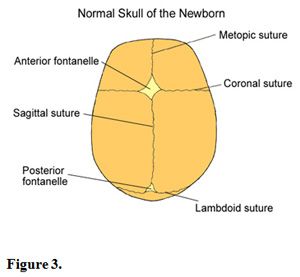Craniosynostosis

A 2-month old boy was seen for a well-child visit by his pediatrician. The child’s mother was concerned that one of his eyes appeared crossed (Figure 1) and that his head was misshapen (Figure 2). The pregnancy was uncomplicated and birth was by normal vaginal delivery. The child was eating well and his development and growth, including head circumference, were age-appropriate. Examination found the anterior fontanelle open and soft. The mother was told that the malformation of the head could be the result of intrauterine compression and of placing the child on his back to sleep (positional plagiocephaly). She was instructed on how to alternate the child’s sleeping positions and on other preventive techniques. She was reassured that most likely the child’s head would improve over the next few months. He was referred to a pediatric ophthalmologist and the eye examination was normal.

At the 4-month visit, the child’s facial asymmetry had gotten worse. His head circumference had fallen from the 68th to the 50th percentile and there was a bulge on the right side of his forehead. The right eye was turned out and there was posterior displacement of the ipsilateral ear. There was a palpable ridge along the right coronal suture area and the anterior fontanelle was almost closed. The remainder of the physical examination was normal. A thin section CT study of the head with 3D reformatting revealed asymmetric coronal craniosynostosis (Figure 2, Arrow) with a small external hydrocephalus. There was asymmetrical facial growth with the right side developing faster. Bulging was also seen at the right temporal area (Figure 2, Arrow). A craniotomy and coronal suture separation were performed when the child was age 7 months. Recovery was uneventful and he achieved all subsequent developmental milestones without delay.
Discussion
The cranial bones develop from the mesenchyme and are well formed by 20 weeks of gestation. Bones are separated by sutures and fontanelle that allow the brain to expand (Figure 3). Craniosynostosis is the result of premature closure of the cranial sutures. Primary craniosynostosis is idiopathic, the exact cause unknown. One hypothesis is that an intrinsic abnormality in the cranial base creates excessive force on the dura that hastens suture closure. Secondary craniosynostosis is the result of failure of brain growth which typically leads to developmental delay. Single suture closure is rarely associated with genetic factors but heredity is strongly correlated with many syndromic causes of craniosynotstosis such as Crouzon, Apert, Carpenter, Chotzen, and Pfeiffer syndromes.

Premature fusion restricts the growth of the skull perpendicular to the affected suture.1 In order to accommodate the growing brain, compensatory skull growth occurs parallel to the affected suture. The resulting skull and associated facial deformity is dependent upon which suture(s) is/are affected.
Surgical correction of primary craniosynostosis is routinely successful with low morbidity and mortality, particularly for otherwise healthy infants whose condition is not part of a broader syndrome.2
Teaching Points
1. Positional plagiocephaly can mask coronal craniosynostosis and further investigation is warranted
2. A crossed or turned eye can be a sign of craniosynostosis and should prompt additional assessment
3. A low threshold of suspicion for craniosynotstosis should guide referral to appropriate pediatric specialists
4. Optimal care for patients with craniosynostosis is best provided by a coordinated multidisciplinary team of healthcare professionals
References:
References1. Morriss-Kay GM, Wilkie AO. Growth of the normal skull vault and its alteration in carniosynostasis: insights from human genetics and experimental studies. J Anat. 2005;207:637â653.
2. Sloan GM, Wells KC, Raffel C, McComb JG. Surgical treatment of craniosynostosis: outcome analysis of 250 consecutive patients. Pediatrics. 1997;100:e2.